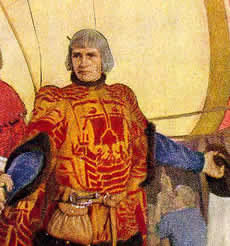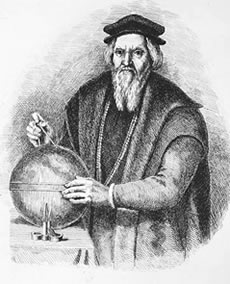World History
Key figures among the European explorers during the age of discovery whose exploits gave important knowledge of the Americas to their European patrons, John Cabot (c. 1451–98) and his son, Sebastian Cabot (c. 1483–1557), have long been a source of controversy and speculation regarding various aspects of their lives and achievements. Probably born in Genoa around 1451, John Cabot moved to Venice in his youth, where he became a naturalized citizen.
Believing, like Christopher Columbus, that he could reach the Far East by sailing west, he journeyed to England in the 1480s, residing mainly in Bristol until March 1496, when King Henry VII granted him the authority to launch an expedition of discovery in his name. Sailing from Bristol on May 20, 1497, with one ship and a crew of 18, he reached the North American coast on June 24. It is not known whether his son, Sebastian, accompanied him.
The precise location of his landing is a matter of some dispute but is generally believed to be Cape Breton Island. Cabot is conventionally credited with “discovering†North America on behalf of his English patrons, even though the fish-rich seas off the coast of northern North America had been visited for most of the previous century by commercial fishermen of various European nationalities.
Regardless of which European first sighted the North American mainland during this era, Cabot’s claims of discovery became the basis for English claims to North America.
Rewarded for his discovery with an annual pension of 20 pounds, Cabot launched a second voyage in 1498. He was never heard from again and is presumed to have died in or near North America. His son, Sebastian, also received a patent from the king of England to continue the explorations begun by his father.
Searching for the fabled Northwest Passage through the Americas to the Far East, he is generally believed to have explored the northern shores of North America, perhaps sailing as far as Hudson Bay, in 1508–09. In 1512, he switched patrons, entering the Spanish service under Holy Roman Emperor Charles V.
In 1518, he was named chief pilot, and in 1526, following the return of the ship of Ferdinand Magellan, he sailed to the RÃo de la Plata region of southern South America, probably searching for gold and other treasure.
In 1530, after the expedition had largely failed, he returned to Spain. In 1548, he switched patrons again, returning to England and in 1553 becoming governor of a joint-stock company, later known as the Muscovy Company, much of whose capital was expended in the failed effort to discover the Northwest Passage.
One of the company’s expeditions did reach the White Sea, culminating in a commercial treaty with Russia and substantial weakening of the Hanseatic League. Sebastian Cabot claimed for himself many of the discoveries and achievements of his father. Until the work of 19th-century scholars, it was thought that Sebastian, not John, had “discovered†North America for the English.
- Vikings In North America
L’Anse aux Meadows With the discovery in 1960–61 of artifacts and the ruins of eight buildings at L’Anse aux Meadows in Canada’s Newfoundland province, archaeologists and historians could at last replace centuries of fable...
- Ferdinand Magellan - Portuguese Explorer
Ferdinand Magellan - Portuguese ExplorerFerdinand Magellan’s exact date of birth is unknown but is believed to be in 1480. His parents were petty nobles. After the return of Vasco da Gama’s expedition from India, Portugal launched subsequent...
- Chicken Bones Suggest Polynesians Found Americas Before Columbus
Were Polynesians in South America before Columbus happened upon the Americas in 1492? Some evidence suggests this is the case. An article by Heather Whipps titled Chicken Bones Suggest Polynesians Found Americas Before Columbus has the details. Whipps...
- History Of The United States Of America
History of the United States of America. Another seemingly impossible task for a short essay. Yet, it reads well and sums up American history in a reasonable fashion. From the site: When the London Company sent out its first expedition to begin colonizing...
- History House Inc.
History House Inc. History like you should have learned it. Bizarre stories, trivia, and books every week. From the site: History House has been dormant for about 20 months now. All of its principals (Ian, Sebastian, Victoria) have not forgotten...
World History
John and Sebastian Cabot - European Explorers
 |
| John Cabot |
Believing, like Christopher Columbus, that he could reach the Far East by sailing west, he journeyed to England in the 1480s, residing mainly in Bristol until March 1496, when King Henry VII granted him the authority to launch an expedition of discovery in his name. Sailing from Bristol on May 20, 1497, with one ship and a crew of 18, he reached the North American coast on June 24. It is not known whether his son, Sebastian, accompanied him.
The precise location of his landing is a matter of some dispute but is generally believed to be Cape Breton Island. Cabot is conventionally credited with “discovering†North America on behalf of his English patrons, even though the fish-rich seas off the coast of northern North America had been visited for most of the previous century by commercial fishermen of various European nationalities.
Regardless of which European first sighted the North American mainland during this era, Cabot’s claims of discovery became the basis for English claims to North America.
  |   |
Rewarded for his discovery with an annual pension of 20 pounds, Cabot launched a second voyage in 1498. He was never heard from again and is presumed to have died in or near North America. His son, Sebastian, also received a patent from the king of England to continue the explorations begun by his father.
Searching for the fabled Northwest Passage through the Americas to the Far East, he is generally believed to have explored the northern shores of North America, perhaps sailing as far as Hudson Bay, in 1508–09. In 1512, he switched patrons, entering the Spanish service under Holy Roman Emperor Charles V.
 |
| Sebastian Cabot |
In 1530, after the expedition had largely failed, he returned to Spain. In 1548, he switched patrons again, returning to England and in 1553 becoming governor of a joint-stock company, later known as the Muscovy Company, much of whose capital was expended in the failed effort to discover the Northwest Passage.
One of the company’s expeditions did reach the White Sea, culminating in a commercial treaty with Russia and substantial weakening of the Hanseatic League. Sebastian Cabot claimed for himself many of the discoveries and achievements of his father. Until the work of 19th-century scholars, it was thought that Sebastian, not John, had “discovered†North America for the English.
- Vikings In North America
L’Anse aux Meadows With the discovery in 1960–61 of artifacts and the ruins of eight buildings at L’Anse aux Meadows in Canada’s Newfoundland province, archaeologists and historians could at last replace centuries of fable...
- Ferdinand Magellan - Portuguese Explorer
Ferdinand Magellan - Portuguese ExplorerFerdinand Magellan’s exact date of birth is unknown but is believed to be in 1480. His parents were petty nobles. After the return of Vasco da Gama’s expedition from India, Portugal launched subsequent...
- Chicken Bones Suggest Polynesians Found Americas Before Columbus
Were Polynesians in South America before Columbus happened upon the Americas in 1492? Some evidence suggests this is the case. An article by Heather Whipps titled Chicken Bones Suggest Polynesians Found Americas Before Columbus has the details. Whipps...
- History Of The United States Of America
History of the United States of America. Another seemingly impossible task for a short essay. Yet, it reads well and sums up American history in a reasonable fashion. From the site: When the London Company sent out its first expedition to begin colonizing...
- History House Inc.
History House Inc. History like you should have learned it. Bizarre stories, trivia, and books every week. From the site: History House has been dormant for about 20 months now. All of its principals (Ian, Sebastian, Victoria) have not forgotten...
